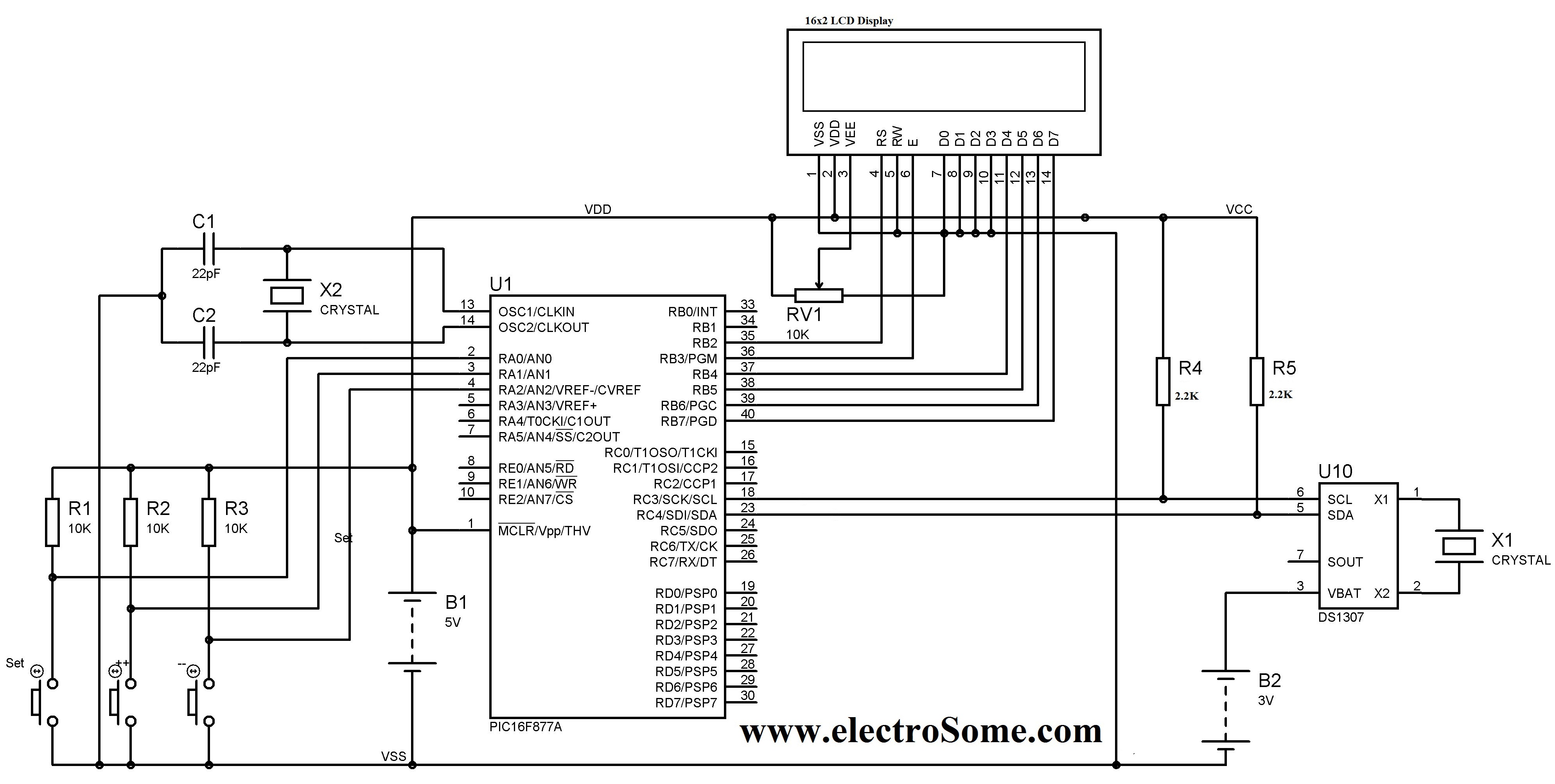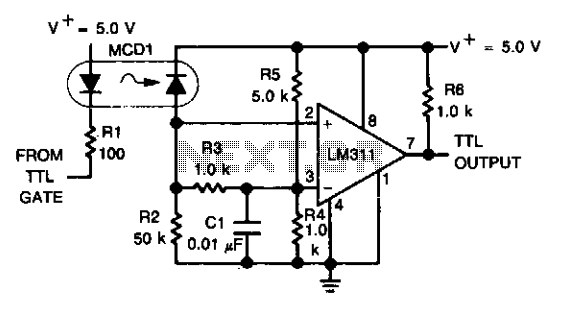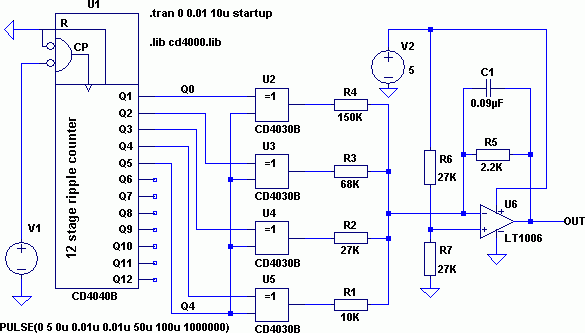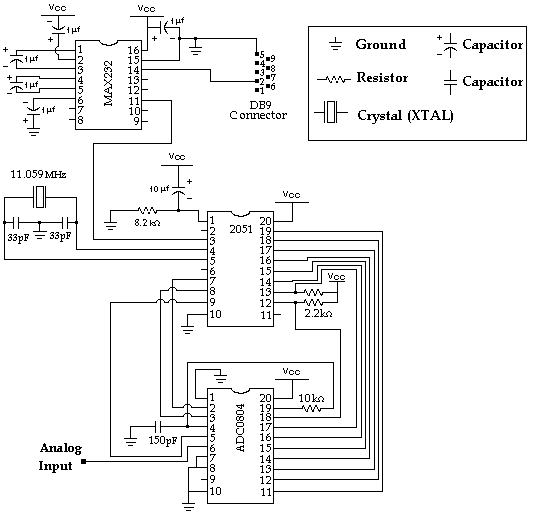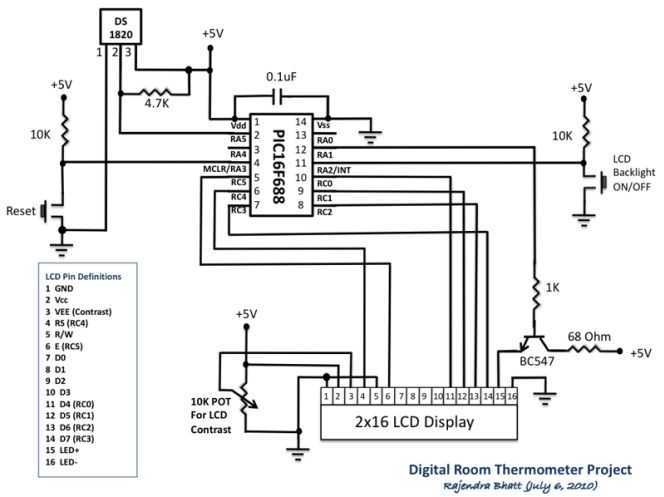
Digital Stopwatch 0-99sec
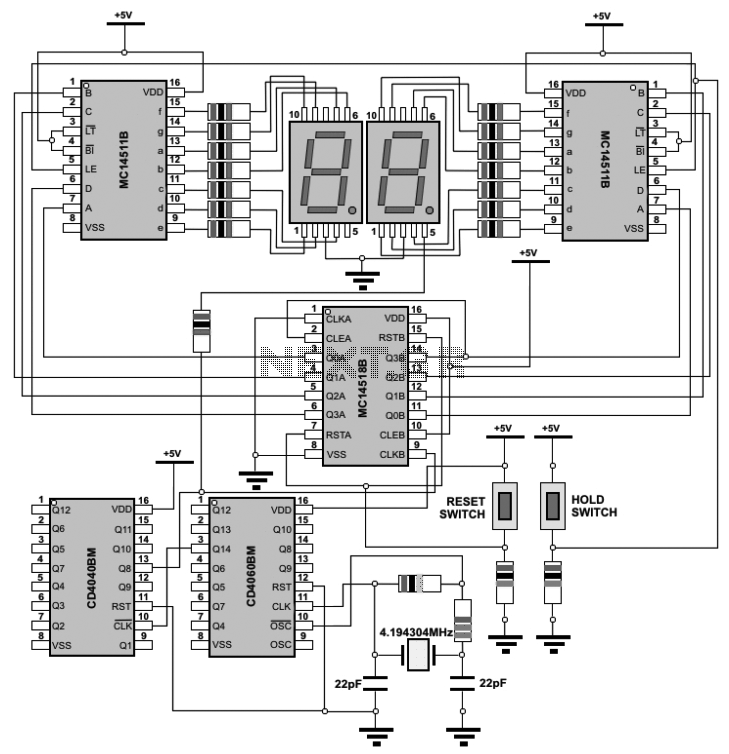
This document describes the function of a digital stopwatch that counts from 0 to 99 seconds. The stopwatch utilizes four integrated circuits from National Semiconductor, although alternative components could achieve similar results. The circuit diagram is presented in an accompanying image. The stopwatch is powered by a 5V supply and receives a pulse from a crystal oscillator. This oscillator's pulse is divided to produce a 1 Hz pulse necessary for the circuit to function correctly and display seconds on 7-segment displays. The description divides the circuit into two main sections: the pulse generator and the counting mechanism. The pulse generator includes the integrated circuits CD4040CM and CD4060CM, with a crystal oscillating at a frequency of 4,194,304 MHz. This high frequency must be divided down to the desired 1 Hz. The CD4060 divides the input frequency by powers of two, with outputs labeled Q4, Q5, and Qn. By inputting a pulse into the CLK of the CD4060, a signal with a frequency of f/2^n is obtained. The output from Q14, when fed a 4,194,304 Hz signal, yields a 256 Hz signal. This signal is then sent to the CD4040, with the output from Q8 providing an inverted 1 Hz signal. This inversion does not affect circuit functionality and is caused by the CLK input inversion. An LED connected to this output visually indicates the counting process, as it lights up with each positive pulse. The 1 Hz signal is then input into a BCD counter, MC14518, which increments its output by one with each pulse. The MC14518 is effectively divided into two segments: one for counting seconds and the other for counting decades. The pulse from the generator is connected to the unit counter, while the decade counter is triggered by grounding the CLK input and using the Q3 signal for the CKE input. This ensures that the decade display increments only when the Q3 signal transitions from high to low. Therefore, the first display counts every 10 seconds, resetting to zero after reaching 9, while the second display increments by one.
The digital stopwatch circuit is designed to accurately count seconds and display the result on two 7-segment displays. The first display represents the units of seconds (0-9), while the second display represents the tens of seconds (0-9). The primary components involved in this design include the CD4060 and CD4040 integrated circuits, which are responsible for frequency division and pulse generation. The crystal oscillator provides a stable frequency source, which is essential for precise timing.
In detail, the CD4060 serves as a frequency divider, taking the high-frequency input from the crystal and reducing it through a series of binary divisions. By connecting the output Q14 of the CD4060 to the CD4040, a further division is achieved, resulting in a 1 Hz output. This output pulse is crucial as it serves as the timing signal for the BCD counter, which counts the seconds. The MC14518 BCD counter is configured to increment its count on each 1 Hz pulse, effectively counting each second.
The design also incorporates a visual feedback mechanism through the use of an LED. This LED illuminates with each pulse, providing a clear indication of the counting process. The choice of using a BCD counter allows for efficient counting and display management, where the unit display increments every second, while the decade display increments every 10 seconds. The logic implemented ensures that the displays reset appropriately, maintaining a seamless counting experience.
Overall, this digital stopwatch design exemplifies a straightforward yet effective approach to time measurement using integrated circuits, demonstrating the principles of frequency division, counting, and digital display interfacing in electronic circuit design.We will describe the function of a digital stopwatch, 0 G 99 sec. The function of the stopwatch, relies in the use of 4 integrated circuits, which in this case belong to National Semiconductor ( It is obvious that other integrated circuits can be used to achieve the same result, however in this case we have used the following parts: The circuit that has been used is shown in picture 1. Through the experimental part we will explain each of the parts function, but in order to have a notion of the basic idea, let just say, that this circuit besides the 5V power supply, is fed with a pulse which comes from a crystal. The crystalG ™s pulse is devided properly in order to obtain the 1 Hz pulse which we need in order for the circuit to work properly, and display the seconds on the 7 segment displays, through a procedure which we will explain through the experimental part.
We will begin the description of the digital circuit above. For our convenience we will devide the circuit to 2 parts: the generator, which produces the pulse of the desired frequency, and the part that does the actual counting. The generator of the circuit comprises of the integrated circuits CD4040CM and CD4060CM. We use a crystal which oscillates at a frequency of 4, 194, 304MHz. It is obvious that this frequency is completely useless, as it is too big to be used as it is to our circuit.
What we should is devide this frequency, in a way that in its final form, the pulse will have a frequency of 1Hz, which is the desirable frequency. Initially we use the integrated CD4060, which devides the imported frequency in its input, by forces of 2.
As we can see on the integrated circuit the outputs are marked as Q4, Q5, G Qn. By importing a pulse in the CLK input of the 4060, with a frequency f Hz, we take out of output Qn, a signal which has a frequency equal to f/2n, . So, by exporting the signal out of Q14, knowing that the imported signal has a frequency of 4, 194, 304Hz, we take a signal, which has a frequency of 256Hz.
By importing this signal, to 4040 and by exporting the signal through Q8 we have finally taken an inverted signal, at the frequency of 1Hz. The fact that the signal is inverted, firstly doesnG ™t affect the proper function of our circuit and secondly is due to the inversion of the CLK input as we can see.
This inversion just causes, the following circuit to be triggered with a logical G 0G . By putting a LED on the same output, we have a visual of the counting, as in each positive pulse the diode polarizes positively, and a current passes through it. The signal of 1Hz, which we have taken from the generator, is imported to a BCD counter MC14518. This integrated circuit adds a logical G 1G at each pulse, on its output. του. . The MC14518 is virtually divided into two segment. One counts the units of the seconds, while the other the decades. As we can see in picture 1, the generators pulse is imported to the part which counts the units. This is very logical, as we want in each secont the number of the display to be raised by 1. On the other hand, we want the first display to raise by 1, every 10 seconds. This is why, we ground the CLK input, and we use the signal of Q3 to the CKE input. By using this means, we make sure that the first display will be triggered, only when we have a decreasing signal on Q3; that is, only when the signal drops from logical G 1G to logical G 0G .
As we can see, the first display increments every 10 seconds, which means that after 9 on the second display (1001 on the output of the BCD counter) the first display must be set to zero, while the first must be set to +1. That is that from 1001 Gƒ 0000, and we have a descending pulse, as the last digit descends from logical G 1G to logical G 0G and triggers the BCD counter of the decades.
When the decades display becomes 9 then the circuit goes to the next state, which 🔗 External reference
The digital stopwatch circuit is designed to accurately count seconds and display the result on two 7-segment displays. The first display represents the units of seconds (0-9), while the second display represents the tens of seconds (0-9). The primary components involved in this design include the CD4060 and CD4040 integrated circuits, which are responsible for frequency division and pulse generation. The crystal oscillator provides a stable frequency source, which is essential for precise timing.
In detail, the CD4060 serves as a frequency divider, taking the high-frequency input from the crystal and reducing it through a series of binary divisions. By connecting the output Q14 of the CD4060 to the CD4040, a further division is achieved, resulting in a 1 Hz output. This output pulse is crucial as it serves as the timing signal for the BCD counter, which counts the seconds. The MC14518 BCD counter is configured to increment its count on each 1 Hz pulse, effectively counting each second.
The design also incorporates a visual feedback mechanism through the use of an LED. This LED illuminates with each pulse, providing a clear indication of the counting process. The choice of using a BCD counter allows for efficient counting and display management, where the unit display increments every second, while the decade display increments every 10 seconds. The logic implemented ensures that the displays reset appropriately, maintaining a seamless counting experience.
Overall, this digital stopwatch design exemplifies a straightforward yet effective approach to time measurement using integrated circuits, demonstrating the principles of frequency division, counting, and digital display interfacing in electronic circuit design.We will describe the function of a digital stopwatch, 0 G 99 sec. The function of the stopwatch, relies in the use of 4 integrated circuits, which in this case belong to National Semiconductor ( It is obvious that other integrated circuits can be used to achieve the same result, however in this case we have used the following parts: The circuit that has been used is shown in picture 1. Through the experimental part we will explain each of the parts function, but in order to have a notion of the basic idea, let just say, that this circuit besides the 5V power supply, is fed with a pulse which comes from a crystal. The crystalG ™s pulse is devided properly in order to obtain the 1 Hz pulse which we need in order for the circuit to work properly, and display the seconds on the 7 segment displays, through a procedure which we will explain through the experimental part.
We will begin the description of the digital circuit above. For our convenience we will devide the circuit to 2 parts: the generator, which produces the pulse of the desired frequency, and the part that does the actual counting. The generator of the circuit comprises of the integrated circuits CD4040CM and CD4060CM. We use a crystal which oscillates at a frequency of 4, 194, 304MHz. It is obvious that this frequency is completely useless, as it is too big to be used as it is to our circuit.
What we should is devide this frequency, in a way that in its final form, the pulse will have a frequency of 1Hz, which is the desirable frequency. Initially we use the integrated CD4060, which devides the imported frequency in its input, by forces of 2.
As we can see on the integrated circuit the outputs are marked as Q4, Q5, G Qn. By importing a pulse in the CLK input of the 4060, with a frequency f Hz, we take out of output Qn, a signal which has a frequency equal to f/2n, . So, by exporting the signal out of Q14, knowing that the imported signal has a frequency of 4, 194, 304Hz, we take a signal, which has a frequency of 256Hz.
By importing this signal, to 4040 and by exporting the signal through Q8 we have finally taken an inverted signal, at the frequency of 1Hz. The fact that the signal is inverted, firstly doesnG ™t affect the proper function of our circuit and secondly is due to the inversion of the CLK input as we can see.
This inversion just causes, the following circuit to be triggered with a logical G 0G . By putting a LED on the same output, we have a visual of the counting, as in each positive pulse the diode polarizes positively, and a current passes through it. The signal of 1Hz, which we have taken from the generator, is imported to a BCD counter MC14518. This integrated circuit adds a logical G 1G at each pulse, on its output. του. . The MC14518 is virtually divided into two segment. One counts the units of the seconds, while the other the decades. As we can see in picture 1, the generators pulse is imported to the part which counts the units. This is very logical, as we want in each secont the number of the display to be raised by 1. On the other hand, we want the first display to raise by 1, every 10 seconds. This is why, we ground the CLK input, and we use the signal of Q3 to the CKE input. By using this means, we make sure that the first display will be triggered, only when we have a decreasing signal on Q3; that is, only when the signal drops from logical G 1G to logical G 0G .
As we can see, the first display increments every 10 seconds, which means that after 9 on the second display (1001 on the output of the BCD counter) the first display must be set to zero, while the first must be set to +1. That is that from 1001 Gƒ 0000, and we have a descending pulse, as the last digit descends from logical G 1G to logical G 0G and triggers the BCD counter of the decades.
When the decades display becomes 9 then the circuit goes to the next state, which 🔗 External reference
